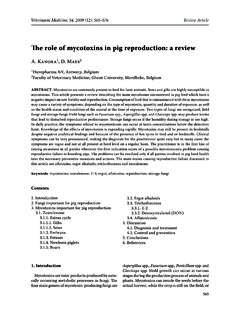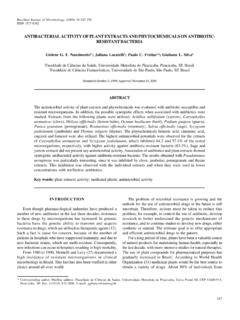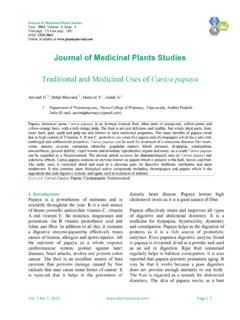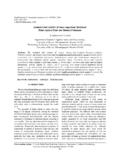Transcription of Essential oils and their use in animal feeds for ...
1 Veterinarni Medicina, 58, 2013 (9): 449 458 Review Article Essential oils and their use in animal feeds for monogastric animals Effects on feed quality, gut microbiota, growth performance and food safety: a review Bento1, Ouwehand2, K. Tiihonen2, S. Lahtinen2, P. Nurminen2, Saarinen2, H. Schulze1, T. Mygind3, J. Fischer3. 1. Danisco animal Nutrition, Marlborough, Wiltshire, United Kingdom 2. Danisco Sweeteners Oy, Nutrition and Health, Kantvik, Finland 3. Danisco A/S, Brabrand, Denmark ABSTRACT: Essential oils (EOs) are important aromatic components of herbs and spices and their biological activities have been known and utilised since ancient times in perfumery, food preservation, flavouring, and medi- cine. Some of their biological activities include antibacterial , antifungal, anti-oxidant and anti-inflammatory effects amongst others.
2 EOs have received attention in recent years as potential natural' alternatives for replacing antibiotic growth promoters (AGPs) in animal diets due to their positive impact on growth performance, gut microbiota and welfare. The purpose of this paper is to provide an overview of our own published and unpublished data on the antibacterial , antifungal and insecticidal activity of thymol and cinnamaldehyde (TC blend), and to describe the effects of this specific EO blend on gut microbiota, growth performance and welfare, carcass characteristics and food safety. The possible modes of action of EOs are discussed and areas for future research are proposed. Keywords: Essential oils; thymol; cinnamaldehyde; antibacterial ; gut microbiota; growth performance Abbreviations AGPs = antibiotic growth promoters, AME = apparent metabolisable energy, BCFA = branched chain fatty acid, EFSA = European Food Safety Authority, ENZ = wheat-formulated xylanase, EOs = Essential oils, F1 = first genera- tion population development, Log10 = base 10 logarithm of a number, MIC = minimum inhibitory concentration, OD = optical density, SCFA = short chain fatty acid, TC = blend of thymol and cinnamaldehyde Contents 5.
3 Modulation of gut microbiota and their fermenta- 1. Introduction tion metabolites by thymol and cinnamaldehyde 2. antibacterial and antifungal activities of thymol 6. Effects of thymol and cinnamaldehyde on growth and cinnamaldehyde performance, welfare and carcass characteristics 3. Stability of thymol and cinnamaldehyde in feed 7. Conclusions 4. Insecticidal properties of thymol and cinnamal- 8. Acknowledgments dehyde 9. References 1. Introduction since 2006, and recent guidelines published by the Food Drug Association are exerting pressure for a Antibiotic growth promoters (AGPs) for animal ban in the US in the near future. To meet market de- diets have been banned in the European Union mands for alternatives to AGPs in animal produc- 449. Review Article Veterinarni Medicina, 58, 2013 (9): 449 458.
4 Tion, Danisco started in 2004 an in vitro screening Phenylpropanes, such as cinnamaldehyde bind program of various EOs in order to establish their with proteins through their carbonyl group, pre- potential antibacterial activity . Several EO blends venting the action of important cell enzymes such were selected based on their antibacterial activity as amino decarboxylases (Burt 2004). Cinnam- and they were tested in vivo. The objective was to aldehyde has been shown to inhibit the growth of develop a blend of EO compounds with synergis- Clostridium perfringens and Bacteroides fragillis, tic properties that support growth performance of but it exhibits weak or no inhibitory activity against monogastric animals fed AGP-free diets. Bifidobacterium longum or Lactobacillus acidophi- EOs are volatile, aromatic compounds synthe- lus (Lee and Ahn 1998).
5 Sised by plants for antibacterial , antifungal and an- The pH of the matrix in which the EOs are present tiviral purposes, and to deter herbivorous insects affects their hydrophobicity which will influence and animals. They are important aromatic compo- their interaction with the bacterial cell membrane, nents of herbs and spices and contribute to natural and therefore, affect the antibacterial action of EOs preservation of foods. The antibacterial proper- across the different segments of the gut. Using an in ties of EOs are well documented and recognised vitro model for pigs, (Michiels et al. 2009) showed (Kalemba and Kunicka 2003) both in vitro (Dorman that thymol and carvacrol have the ability to in- and Deans 2000; Ouwehand et al. 2010) and in vivo hibit lactobacilli in the stomach more so than in (Mitsch et al.)
6 2004; Tiihonen et al. 2010). the small intestine. The inhibitory effect of thymol In vitro studies also suggest that combination of against lactobacilli is beneficial in the proximal gut individual EOs has a greater antibacterial effect than to reduce the risk of acidosis, and the stimulatory individual EOs alone, indicating a synergy between effect of cinnamaldehyde on lactobacilli is benefi- single activities (Burt 2004; Lee et al. 2004b). Due cial in the distal gut to prevent the proliferation of to this synergistic activity , a blend of two carefully undesirable microorganisms. balanced nature-identical EO compounds, thymol The impact of pH on the biological activity of EOs and cinnamaldehyde (TC blend), was selected due and their ability of affecting the bacterial growth to their combined antibacterial activity against po- of some undesirable bacterial species makes them tentially harmful bacteria and because they spare ideal candidates as gut bacterial modulators.
7 As a some of the beneficial intestinal bacteria. result, the inclusion of EOs in animal diets could EOs comprise a diverse group of components potentially minimise the occurrence of intestinal with different structures and chemical properties; diseases caused by undesirable bacteria, and could for example, cinnamaldehyde is an aliphatic alde- favour the growth of beneficial gut microbiota sup- hyde, whereas carvacrol and thymol are phenolic porting growth performance. compounds. Due to differences in their chemical structure, both groups differ in their mechanism of antibacterial action. In principle, both compounds 2. antibacterial and antifungal activities are able to disturb the integrity and function of of thymol and cinnamaldehyde bacterial cell membranes (Di Pasqua et al.)
8 2007). It is therefore not likely that the antibacterial activity In vitro, pure cultures of various microbes have of EOs can be attributed to one specific mecha- been exposed to increasing amounts of EOs under nism, but rather to the interaction between the EO anaerobic conditions (Ouwehand et al. 2010). The chemical structure and a variety of targets in the tested C. perfringens strains were found to be sensi- bacterial cell. This makes it difficult to predict how tive to carvacrol, cinnamaldehyde, citral, limonene susceptible to EOs a bacterial species is. and thymol, particularly at higher concentrations Monoterpene phenols, such as thymol and carva- (500 mg/l) and to oregano oil, rosemary oil and crol, interact with the cell membrane by hydrogen thyme oil. Salmonella serovars that were tested, bonding, rendering the membranes and mito- were found to be sensitive only to high (500 mg/l).
9 Chondria more permeable and disintegrating the concentrations of the selected EOs, while E. coli outer cell membrane. They can inhibit the growth was sensitive to most of the tested EOs at lower of Escherichia coli O157:H7, Staphylococcus au- concentrations (5 and 50 mg/l). Bifidobacterium reus, Salmonella enterica serovar Typhimurium, longum, B. breve and L. reuteri were less sensitive to Pseudomonas fluorescens, and Brochothrix ther- most of the tested EOs, while B. animalis ssp. lactis mosphacta (Di Pasqua et al. 2007, 2010). and L. fermentum were relatively sensitive at lower 450. Veterinarni Medicina, 58, 2013 (9): 449 458 Review Article concentrations (5 and 50 mg/l). With the exception Table 1. Minimum inhibitiory concentrations (MICs) in of Salmonella and E. coli, all tested microbes were mg/ml of thymol (99% purity); trans-cinnamaldehyde sensitive to the AGP avilamycin (Ouwehand et al.)
10 (98% purity) against fungal target strains 2010). These findings indicate that one of the ad- Fungal species Thymol Cinnamaldehyde vantages that EOs may have over AGPs is that they have a better selectivity profile in that they spare Saccharomyces cerevisiae the beneficial intestinal bacteria. Zygosaccharomyces bailii < From these initial pure cultures and single EO. Rhodotorula mucilaginosa tests, it was concluded that a blend of thymol and cinnamaldehyde (TC) would have the best potential Rhodotorula glutinis < to be of benefit to commercial animal production. Pichia anomala Subsequent tests showed that this specific blend Kluyveromyces marxianus of EOs (TC) exerts a growth inhibition of at least 50% towards the Gram-negative bacterial species Candida parapsilosis (Figure 1) with E.













